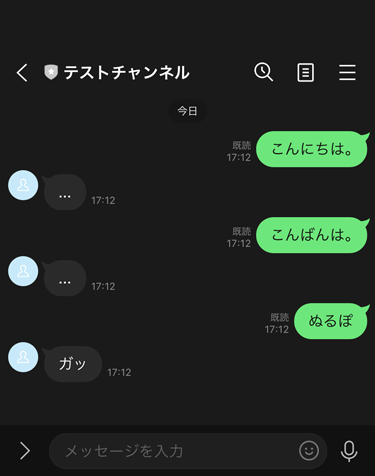
以前、LINEBot用のスクリプトを作成しましたが、その際はNgrokをつかって公開し、動作を確認しました。
しかし、実際に永続的に運用していこうとなると、APIとしてどこかしらで動かし続けた方がよさそうです。
今回は、Next.jsを使って、VercelかNetlifyで公開してみようと思います。
ソースコード
.env
CHANNEL_SECRET=LINEのチャネルシークレットを記載 CHANNEL_TOKEN=LINEのチャネルアクセストークンを記載
package.json
{ "name": "line-bot", "version": "0.1.0", "private": true, "scripts": { "dev": "next dev", "build": "next build", "start": "next start", "lint": "next lint" }, "dependencies": { "@line/bot-sdk": "^9.0.3", "next": "14.1.3", "react": "^18", "react-dom": "^18" }, "devDependencies": { "@types/node": "^20", "@types/react": "^18", "@types/react-dom": "^18", "dotenv": "^16.4.5", "eslint": "^8", "eslint-config-next": "14.1.3", "typescript": "^5" } }
src/pages/api/line/send.js
// 定型文の送信 import * as dotenv from 'dotenv'; import { Client } from '@line/bot-sdk'; dotenv.config(); const { CHANNEL_SECRET, CHANNEL_TOKEN } = process.env; const config = { channelSecret: CHANNEL_SECRET, channelAccessToken: CHANNEL_TOKEN }; const client = new Client(config); export default async function handler(req, res) { if (req.method === 'POST') { try { const messages = [{ type: 'text', text: 'Hello World.' }]; await client.broadcast(messages); } catch (err) { console.log(err); } res.status(200).json({ method: 'POST' }); } else if (req.method === 'GET') { res.status(200).json({ method: 'GET' }); } }
src/pages/api/line/reply.js
// 定型文の返信 import * as dotenv from 'dotenv'; import { Client } from '@line/bot-sdk'; dotenv.config(); const { CHANNEL_SECRET, CHANNEL_TOKEN } = process.env; const config = { channelSecret: CHANNEL_SECRET, channelAccessToken: CHANNEL_TOKEN }; const client = new Client(config); export default async function handler(req, res) { if (req.method === 'POST') { await Promise.all((req.body.events || []).map((event) => (async () => { switch(event.type) { case 'message': { return client.replyMessage(event.replyToken, { type: 'text', text: 'Hello World.' }); } } })())); res.status(200).json({ method: 'POST' }); } else if (req.method === 'GET') { res.status(200).json({ method: 'GET' }); } }
src/pages/api/line/null-pointer-exception.js
// メッセージに応じたテキストの返信 import * as dotenv from 'dotenv'; import { Client } from '@line/bot-sdk'; dotenv.config(); const { CHANNEL_SECRET, CHANNEL_TOKEN } = process.env; const config = { channelSecret: CHANNEL_SECRET, channelAccessToken: CHANNEL_TOKEN }; const client = new Client(config); export default async function handler(req, res) { if (req.method === 'POST') { await Promise.all((req.body.events || []).map((event) => (async () => { switch(event.type) { case 'message': { if (/^ぬるぽ$/.test(event.message.text)) { return client.replyMessage(event.replyToken, { type: 'text', text: 'ガッ' }); } else { return client.replyMessage(event.replyToken, { type: 'text', text: '...' }); } } } })())); res.status(200).json({ method: 'POST' }); } else if (req.method === 'GET') { res.status(200).json({ method: 'GET' }); } }
定型文の送信、定型文の返信、メッセージに応じたテキストの返信の3パターンを、send.js、reply.js、null-pointer-exception.jsとしています。
これを、VercelやNetlifyにデプロイすればURLが発行されるので、LINE Developers にログインし、チャンネルの「Messaging API設定 > Webhook設定 > Webhook URL」から、WebHookのURLに設定すればOKです。